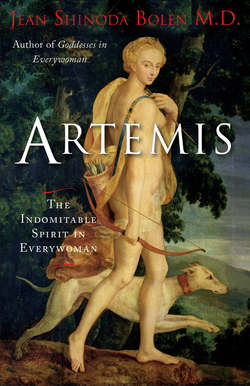Читать книгу Artemis - Jean Shinoda Bolen - Страница 10
На сайте Литреса книга снята с продажи.
Goddess Archetypes in Everywoman
ОглавлениеGoddesses in Everywoman introduced a new psychology of women based on archetypal patterns personified by eight major goddesses in classical mythology, one of whom was Artemis, archetype of the sister, competitor, goal achiever, and feminist. All archetypes are potentially active in every person—as lived out in us, projected onto others, or recognized when encountered in ancient myths or contemporary films. Just as we come into the world with innate natural gifts and personality traits that may be encouraged or suppressed depending upon expectations of family and society, so it is for the archetype of Artemis that Atalanta personifies.
The Artemis archetype was expressed at Seneca Falls in 1848, in the Declaration of Sentiments that was the beginning of the Women's Suffrage Movement, only one of which was the rallying issue of the right to vote. It took until 1920 for American women to gain this right through a constitutional amendment. Feminists in the mid-1960s through the 1970s emphasized sisterhood. They demanded equal access to education, jobs, and professions; they insisted on opportunities for girls to participate in sports; they demonstrated for reproductive rights. Thanks to their efforts, gains were made that rippled out into the world, but there was not enough support to pass the Equal Rights Amendment.
Even with the liberation of Artemis in American culture, there are some who hold to the same assumptions and values prevalent in cultures where a girl belongs to and obeys her father until she marries, after which she becomes her husband's possession. In these cultures, a woman's role is to maintain the household, please her husband, and bear male children. She must maintain her physical virginity before marriage, or at least the appearance of it. Sexuality is not for her own enjoyment, but for her husband's pleasure and the procreation of children. When virginity is the hallmark of value and honor, with bride price or dowry dependent upon it, women do not belong to themselves; they lack sovereignty and independence. When Hillary Clinton addressed the Fourth UN World Conference on Women in Beijing in 1995 with the ringing assertion that “Women's rights are human rights and human rights are women's rights,” she brought attention to the reality that human rights are not extended to women—that democracy, even where it exists, often can only apply to men.
Artemis embodies the virgin-goddess archetype, a woman who is one-in-herself psychologically. She may or may not be a virgin physically; she may be of any age. The archetypal part of her maintains autonomy in her inner life, even when it is not allowed outward expression. She may need to keep her feelings, thoughts, and imagination of a different life to herself until she is old enough to leave a fundamentalist family headed by an authoritarian father. Or until she can join other women to express or protest, such as the women in India who demonstrated against authorities who disregard rape, those who joined One Billion Rising and danced in streets to end violence against women, or took part in the Arab Spring uprisings.
